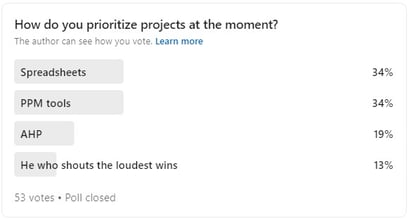Prioritization Spreadsheet: 6 Reasons It's Destroying Value
Updated:
Published:
As a seasoned expert at low quality Home Improvements, I know that there are very few jobs that can’t be done with duct tape, super glue and Polyfilla. Solving problems with the wrong tools and no skills. What could possibly go wrong?  Similarly, we all know that there are very few problems that cannot be fixed with a spreadsheet, right? Build a quick database? Organise your sales pipeline? Create charts for your investors? Manage your taxes? We’ve got a spreadsheet for that!
Similarly, we all know that there are very few problems that cannot be fixed with a spreadsheet, right? Build a quick database? Organise your sales pipeline? Create charts for your investors? Manage your taxes? We’ve got a spreadsheet for that!
Now technically you probably could (and possibly have) been able to do just this. But (like my home improvements) how often do you regret that initial decision to ‘just put it in a spreadsheet’ rather than take the time to get the right tool for the job?
Having witnessed the rise of AWS, Salesforce, Tableau, Power BI and a plethora of other data titans it’s fair to say the sector has evolved to offer better choices (much as my home improvements have given way to calling Gary).
 Yet, when we surveyed people on LinkedIn to tell us how they were prioritizing, spreadsheets were still top (albeit tied with PPM tools, to be fair) so we’ve clearly got a long way to go on this transition. And this makes sense – spreadsheets are familiar, and you don’t have to ask finance for budget – making a change feels uncomfortable… do you really want to make that change now?
Yet, when we surveyed people on LinkedIn to tell us how they were prioritizing, spreadsheets were still top (albeit tied with PPM tools, to be fair) so we’ve clearly got a long way to go on this transition. And this makes sense – spreadsheets are familiar, and you don’t have to ask finance for budget – making a change feels uncomfortable… do you really want to make that change now?
Yes, of course you do! And here are 6 reasons why:
1. "Free" spreadsheets are NOT free
Let's nail this one quickly: your prioritization spreadsheet is costing you money every single day.
"The Magic Spreadsheet" is typically not a very effective way to make decisions. In fact, PMI research shows that 20% of the projects in a typical portfolio are so badly aligned with your organization's goals that they should be stopped tomorrow. Most people are using spreadsheets for this (or PPM tools which are spreadsheet-logic built into software). In other words, your spreadsheet is giving you a portfolio with 20% waste built in!
If you're spending $5,000,000 a year on your projects, your spreadsheet is costing you $1,000,000. Let's say there are 260 work days in a year; that means your spreadsheet is costing you $3,846 per day!
But it's worse than that. You could be spending that money on "good projects". If we assume a typical project has an return on investment of around 3x. So we're not wasting $1,000,000 of spending, we're missing out on $3,000,000 of value and...
...your spreadsheet is costing you around $10,000 in lost business value... EVERY SINGLE DAY!
So please, let's not talk about "free" spreadsheets.
Read more: The Spreadsheet Paradox: Free to Use, But Costs Millions on Misaligned Projects
2. Spreadsheets make mistakes
Research shows that only 1 in 10 spreadsheet is error free. I’m not totally sure how this research has been done, or indeed how accurate it is, but the quantum of the problem is clear. It’s just way too easy to drag a formula a little too far, or to mess up your VLOOKUP by adding in an extra column. Most of us have had that sinking feeling when we see these errors, hope that they’ve not been seismically catastrophic, and patched it up.
Is this really a risk you want to plumb into your progressive tech-enabled planning process? When there are $millions being potentially mis-managed is that ‘free’ spreadsheet still good value?
3. People don’t like Black Box solutions
Anyone who has managed a planning process powered by a big spreadsheet knows that moment when a foot dragging participant sucks in the air through their teeth, and asks, “how can we really trust this model – it’s just such a Black Box”. This challenge can be heartfelt, politically motivated… or a bit of both. But it’s tricky. At best you’re scrambling to document all the bodges, at worst you’re struggling to recall why you used that percentage in the bright yellow input field, and what exactly does that “Adjustment Factor” line means.
Does any of this sound familiar? If so, you probably realise that the ‘free’ spreadsheet has some nasty hidden costs when it comes to organisational alignment.
4. Spreadsheets don’t benefit from Decision Science
Thinking specifically about scoring options, spreadsheets are powered by inputs – the answer is 23.7, put it into Cell DX3032 (colored a nice shade of magenta) and you’ve got your answer. But humans simply don’t work like that. It’s been proven that people are far more able to think in terms of relative importance or relative size, than to create a value in the abstract. This is the fundamental principle of AHP – Analytic Hierarchy Process – and has led to the development of a large body of best practice relating to both Pairwise & Verbal Scale based scoring.
In theory this can be built in a spreadsheet – but it’s overly complicated, not advisable, and certainly not free, assuming you put value on your time, sanity and peace of mind.
5. Teams are smarter than individual people
Scores are subjective perspectives, crystallized into data points. The fact that you have a number does not mean you create truth – you simply quantify bias. Most judgements that power organizations remain exactly this – subjective human perspectives (subject to AI enabled robot take-over perhaps). And this is great – inherent in human judgement is millions of years of evolution, topped off with professional experience and (probably) a bit of L&D. However, better still is a syndicated perspective of a group of people working together to share knowledge and create the ‘wisdom of the team’.
The time and positivity of your team is the most valuable resource you have – choosing to use the cheapest solution available to capture their insight is not a smart saving.
Read more: Collaborative Decision-Making - The Ultimate Guide
6. Spreadsheets don’t make it simple to collect data
Data collection is painful. Chasing people to fill in spreadsheets, managing different versions of submitted data, finding stale data, hunting through email attachments for updates to copy into ‘the master’… If these are not familiar then relax. Your spreadsheet enabled process clearly works better than any that I’ve used. If it does, take a moment and ask yourself that question again…
Watch: Spreadsheets are Not Free
To provide you with a deeper understanding of this subject, let's hear it from the experts, Amanda Oakenfull and Stuart Easton, who discuss the role of tools in project and portfolio management and how to effectively use them.
In this webinar, Amanda and Stuart discuss the limitations of using spreadsheets for complex projects and highlight the importance of selecting the appropriate tools for different project sizes. They also emphasize the importance of training in using these tools efficiently. This discussion complements our points on why spreadsheets may not be the best choice for prioritizing your projects and offers practical advice on alternatives.
Feel free to watch the entire webinar or if you're short on time, here's a summary:
-
The Importance of Tools Alignment: They emphasize how crucial it is for the tools to be aligned with the objectives and scale of the project. Using spreadsheets for complex projects with dynamic data can lead to inefficiency and errors.
-
Risk of Errors with Spreadsheets: The speakers mention that while spreadsheets are versatile, they are prone to human errors and might not offer the level of accuracy required for large projects.
-
Training and Skill Development: Amanda and Stuart discuss the importance of not only selecting the right tools but also ensuring that team members are properly trained to use them efficiently.
-
Better Alternatives to Spreadsheets: They touch upon alternatives such as project management software, which are designed to handle the complexities that spreadsheets can’t. Tools like these often have features for real-time collaboration, automated reporting, and more.
-
Stakeholder Engagement and Communication: The speakers talk about how the right tools can facilitate better stakeholder engagement and communication, which is essential for the successful execution of projects.
-
Cost Effectiveness in the Long Run: Though spreadsheets might seem cost-effective initially, the speakers highlight how using specialized project management tools can be more cost-effective in the long run by reducing errors and saving time.
Case Studies: Project Prioritization Spreadsheets that BITE!
In the webinar, Stuart Easton, one of the founders of TransparentChoice, discusses project prioritization with Roberto Camanho, an experienced consultant who has been in the field for over 30 years. Roberto shares two case studies from his experience:
Case 1: Brazilian electric power company
The first case involved a Brazilian electric power company that was struggling with enterprise-level project prioritization. They attempted to develop a model internally, but it was flawed. Despite the considerable time and effort invested, the company couldn't rank the projects efficiently or accurately.
Roberto mentioned that they used a 1-3-5 scale, which was inappropriate for their case. He later introduced them to a more robust and proven methodology called the Analytic Hierarchy Process (AHP), which proved to be more effective and aligned with their needs.
Case 2: International oil and gas company
The second case involved an international oil and gas company that tried to create a model internally using bright engineers. However, like the first case, they did not follow a proven methodology and ended up with a flawed model. Roberto was called to analyze the data and applied the AHP methodology, which significantly improved the project prioritization process.
Roberto emphasizes that a well-tested methodology like AHP is essential for efficient project prioritization. The stakeholders' involvement and ownership in the process are also crucial. Following a proven methodology leads to better results and stakeholder buy-in, while improvisation or relying on unproven methods can result in wasted time and resources.
Isn’t there a better way of doing this?
If you’re nodding right now then it’s time to think about Project Prioritization solutions. At TransparentChoice we’ve been working on making your planning process better and more inclusive, and would love the chance to help you say goodbye to that spreadsheet, and hello to tech-enabled collaborative Project Prioritization.

